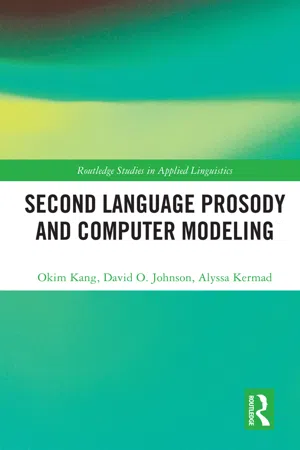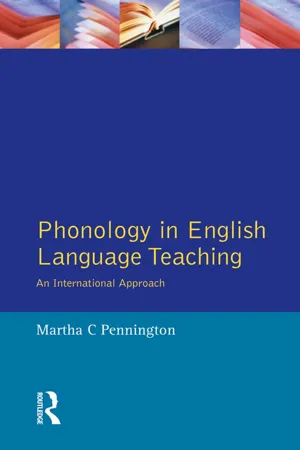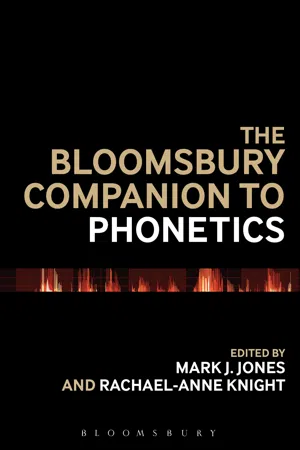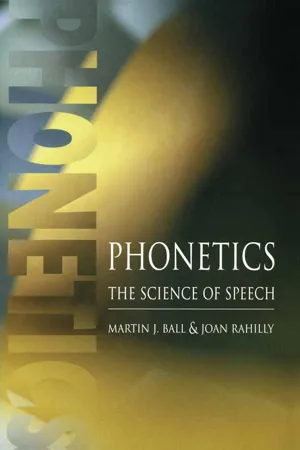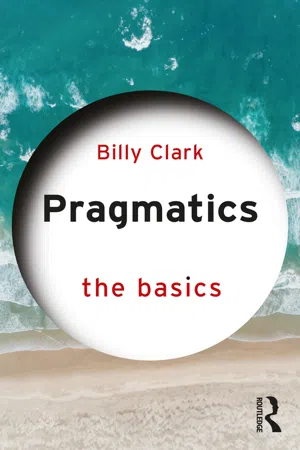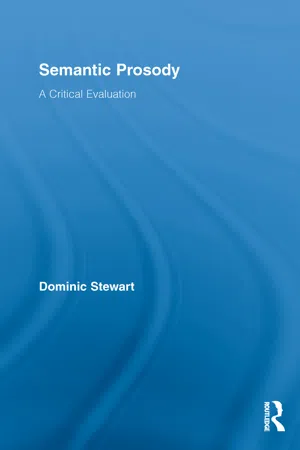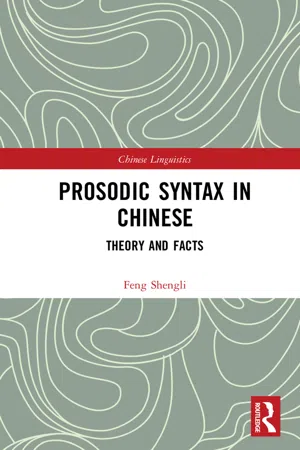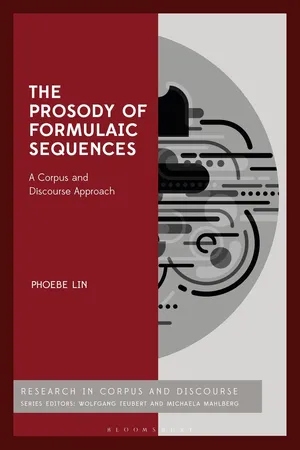Languages & Linguistics
Prosody
Prosody refers to the rhythm, intonation, and stress patterns in language. It encompasses the musical and expressive aspects of speech, including pitch, tempo, and pauses. In linguistics, prosody plays a crucial role in conveying meaning, emotion, and emphasis, and is studied to understand how these elements contribute to communication and interpretation.
Written by Perlego with AI-assistance
11 Key excerpts on "Prosody"
- eBook - ePub
- Okim Kang, David O. Johnson, Alyssa Kermad(Authors)
- 2021(Publication Date)
- Routledge(Publisher)
Part ILinguistic Foundations of Prosody
Passage contains an image
1 Overview of ProsodyProminent Points This chapter presents an overview of the following:1.1 What Is Prosody?1.2 The Role of Prosody in Discourse1.3 History of Prosodic Approaches1.4 The British Tradition1.5 The American Tradition1.6 Summary1.1 What Is Prosody?The process of human communication, specifically communication through speech, is a complex, multi-faceted phenomenon. At any given time, when an utterance is made by a speaker, there are numerous linguistic processes simultaneously at play. First of all, a speaker must construct an utterance by putting words together in a certain order which conforms to the target language syntax in what is typically described as the “grammar” of the language. These constructions are made up of appropriate words which convey meaning, or the “semantics” of the language. The words themselves are made up of sounds placed into a particular order which connect with other sounds in what is known as the “phonology” of the language. Each individual sound is uniquely articulated and co-articulated depending on the environment, and this process involves the “phonetics” of the language. This hierarchy of linguistic building blocks of speech encompasses several of the processes at play in communication (syntax, semantics, phonology, phonetics). There is another linguistic process which is spread out over all of these processes, and that is Prosody.Crystal (2008) defines Prosody in the following way:A term used in suprasegmental phonetics and phonology to refer collectively to variations in pitch, loudness, tempo and rhythm. Sometimes it is used loosely as a synonym for “suprasegmental”, but in a narrower sense it refers only to the above variables, the remaining suprasegmental features being labelled paralinguistic.(p. 393) - eBook - ePub
English Rhythm and Blues
Where Language and Music Come Together
- Patrice Paul Larroque(Author)
- 2021(Publication Date)
- Routledge(Publisher)
1 He considers meter like a dividing agent which consequently implies the existence of a whole. Conversely, he describes rhythm as a uniting agent which actually contributes to the building of a whole and makes it progress. The progression can be organized around the periodical occurrence of stress patterns.In linguistics, the study of stress and rhythm is part of the science of Prosody. Prosody can be defined as the rules, or rather the principles, which govern duration, pitch, amplitude, frequency, loudness, and pause in vocal music. When he or she talks, a speaker naturally puts rhythm in his speech, that is, by articulating or punctuating, by making syllables more prominent than others. In an utterance in English, strong beats are perceptually salient and generally coincide with important meaningful words; the others elements of the utterance will be unaccented.Prosody is also sensitive to syntax, morphology, the intended meaning conveyed by speech and enunciation: fluency, utterance rate, focus, etc. (cf. for example Schlüter 2005 : 17). While meter can be regarded as an inner phenomenon, as a process of measuring literary composition, rhythm, which is linked with the perceptual aspect of speech, will apply to the different patterns and variables of spoken language.The present discussion will first be an attempt to circumscribe what the notion of rhythm represents, its beats, tempo, and (especially African) influences. In this first part, the ideal eurhythmic structure of English is dealt with; it is, however, a structure which may present infractions. A second part is devoted to compensatory measures which aim at repairing these violations and thus restore the natural rhythm of English speech.2.2 RhythmThe word “rhythm” comes from Latin rhythmus, derived from Ancient Greek ρυθμός (rhuthmos, from the verb ρεϊν, “rhein,” flow - eBook - ePub
Phonology in English Language Teaching
An International Approach
- Martha C. Pennington(Author)
- 2014(Publication Date)
- Routledge(Publisher)
It is then a short step to phonological markers and stereotypes which indicate meaning that can override and contradict the lexical meaning of the words and can therefore be used to intentionally deceive or confuse. Thus, when a person's voice says one thing and his/her words say another, we tend to believe the voice, not the words. In addition, when certain voice qualities are regularly associated with certain social roles or socially defined groups, they are easily recognized by people for what they symbolize and so can be used to parody or to ridicule.From the foregoing discussion, it can be concluded that Prosody – taken as a complex of voice quality, intonation, rhythm, stress and phonological fluency – fulfils a wide range of communicative functions. In English, Prosody functions as:(1) a direct, iconic indicator of the significance of information (e.g. as of greater or lesser importance);(2) an emblematic indicator of a grammatical pattern (e.g. statement vs. question);(3) a symptom of an emotional state or attitude (e.g. uncertainty vs. certainty);(4) a signal of a certain stance or role taken by the speaker (e.g. condescension or authority);(5) a marker of a socially or geographically defined group (e.g. speakers from a certain region or ethnic group);(6) a symbol of a particular social role (e.g. femininity vs. masculinity);(7) a defining characteristic of a particular type of interaction (e.g. “adult talk” vs. “baby talk");(8) a representation, whether genuine or not, of a speaker characteristic, condition or role;(9) an index of a speaker's individual identity.In sum, the dividing lines between Prosody in its function as marking out information units and as communicating various types of expressive and social meanings are by no means clearcut. The range of meanings of Prosody, as summarized in Figure 4.7 , can be described as a continuum from presentational, in which the relationship between sound and meaning is simple and direct, to representational - eBook - ePub
- Mark J. Jones, Rachael-Anne Knight, Mark J. Jones, Rachael-Anne Knight(Authors)
- 2013(Publication Date)
- Bloomsbury Academic(Publisher)
8 Prosody Lluisa AstrucChapter Overview Introduction Acoustic Parameters of Prosody Prosodic Subsystems: Stress, Rhythm and Intonation Conclusion1 IntroductionProsody covers all aspects of stress, rhythm, phrasing and intonation in speech.1 Some important prosodic distinctions are conveyed in writing using commas, colons, semi-colons and other punctuation marks:(1)a) Politicians can’t talk, honestly.b) Politicians can’t talk honestly.In (1a), the adverb honestly is separated by a prosodic break (represented by a comma in writing) which indicates that this adverb is a sentential adverb modifying the whole sentence and its meaning is equivalent to ‘in my honest opinion’. In (1b), honestly is a manner adverb modifying the verb; its meaning is ‘[to talk] with honesty’. Parenthetical comments and restrictive relative clauses are generally both set aside by prosodic breaks and uttered with a faster tempo. Changes in rhythm, phrasing and intonation can thus convey syntactic and semantic information.Another function of Prosody is structuring the phonology. The units of phonology, from the segment up to the utterance, are organized into a prosodic hierarchy (see Table 8.1 ); segments form syllables, syllables form feet (a foot is a strong syllable and one or more weak syllables; for example, water has a strong and a weak syllable), feet can be combined to form multisyllabic words (watermelon has two feet with a strong and a weak syllable each) and words form different types of phrases. This hierarchical ordering of prosodic elements is known as the prosodic structure and is part of the phonology of a language (e.g. Selkirk, 1978; Nespor & Vogel, 1986).Table 8.1 The elements of the prosodic structureTable 8.2 The phonetic aspects of stress, rhythm and intonationIn the speech signal, prosodic distinctions are conveyed by a set of acoustic parameters: duration, intensity and pitch. The combination of these parameters is perceived as stress, rhythm and intonation, which are the main subsystems of Prosody. We see above (in Table 8.2 - eBook - ePub
Phonetics
The Science of Speech
- Martin J Ball, Joan Rahilly(Authors)
- 2014(Publication Date)
- Routledge(Publisher)
stress, length, pitch, intonation, voice quality and co-articulation constitute the suprasegmental (i.e. above segmental level) or prosodic properties of speech. The term ‘Prosody’ derives from the Greek verb meaning ‘to sing with’ or ‘accompanying’. Prosodic aspects of speech, therefore, are those which accompany the segmental strings. While the prosodic aspects which we have mentioned above can, of course, relate to individual segments (a segment can be short or long as in [a] versus [a⧗], for example, and it can be uttered on a particular pitch), we tend to discuss prosodic aspects in relation to larger domains, i.e. the syllable, words and longer utterances. The importance of prosodic aspects of speech —————— There is no doubt that prosodic aspects of speech are important. For example, we have stated above that a speaker’s choice of pitch contour can help to indicate whether the utterance is a statement or a question and we have shown that stress location has a disambiguating role with relation to meaning. Perhaps even more crucially, in so-called tone languages such as Chinese, the pitch shape of a syllable performs a phonemic function. In tone languages, speakers must use particular pitch patterns in order to differentiate word meaning. For example, McCawley (1978, p.120) states that the syllable [ma] in Mandarin Chinese has four possible meanings, depending on the tone which accompanies it, as follows: [ma] high level pitch: ‘mother’ [ma] high rising pitch: ‘hemp’ [ma] low, or falling then rising pitch: ‘horse’ [ma] falling pitch: ‘cold’ So, it is clear that prosodic aspects of speech have communicative and linguistic relevance. It is also the case that Prosody has paralinguistic importance. We may, for example, manage to judge speakers’ attitudes or emotions based largely on the prosodic cues which exist in their speech - eBook - ePub
- Billy Clark(Author)
- 2021(Publication Date)
- Routledge(Publisher)
It is hard to account for all of the effects of Prosody. For tone languages, it is clear that the tones are part of language and contribute to linguistic meaning. In languages like English, there is debate about whether we should treat Prosody as semantic or pragmatic. One reason for seeing Prosody as semantic is that some aspects of it vary according to the speaker’s dialect, e.g. speakers of some varieties in Belfast, Glasgow, Newcastle, and Liverpool typically produce statements with a low rise while speakers of other varieties are likely to produce these with a falling tone. The ways that context interacts with Prosody make it seem pragmatic. For example, a rising tone accompanying (21) is likely to suggest that the speaker is asking a question but the speaker can also ask a question with a falling tone here:- (21) You’re enjoying this book.
A significant difference between (21) and (17), which we looked at above, is that we would usually assume that the hearer of (21) is in a better position than the speaker to know whether they are enjoying the book. For (17), there is no reason (without further contextual assumptions) to think that either the speaker or the hearer has more insight into whether Calum likes the book. This is one possible reason why we are more likely to ask a question with a falling tone when saying (21) than (17), and also evidence for the role of pragmatics in understanding Prosody.There is arguably a third kind of language, called a ‘pitch-accent language’, where the placing of pitch-accents (which make particular syllables prominent) differentiates words (languages which have been described as pitch-accent languages include Basque, Japanese, Norwegian, Slovene, and Turkish). Arguably, English has a very small amount of this feature but only for words such as record and rebel where the noun version has an accent on the first syllable while the verb has an accent on the second syllable.As we are interested in pragmatics rather than the linguistic system here, we will not say more about the use of Prosody to identify words in tone and pitch-accent languages.All languages have Prosody, including sign languages. Sign languages share all the properties of spoken languages apart from the use of sounds produced by the control of airflow from the diaphragm up through the body and out through the nose or mouth. Sign languages have phonemes, morphemes, words, phrases, and clauses just as spoken languages do. They also have prosodic features, i.e. things which affect understanding without contributing to the production or perception of phonemes. In sign languages, prosodic features include such things as the duration of a sign, pauses, facial expressions, how open the eyes are, and the use of the signing space. So the questions we ask about Prosody affect sign languages too. - Jeanne Fahnestock, Randy Allen Harris, Jeanne Fahnestock, Randy Allen Harris(Authors)
- 2022(Publication Date)
- Routledge(Publisher)
Part II Enduring Features of Persuasive LanguagePassage contains an image
7 Sonic Rhetoric The Persuasive Power of Spoken Language
Gabrijela KišičekDOI: 10.4324/9780367823658-107.1 Introduction
If we understand rhetoric as the art of persuasion, we can understand sonic rhetoric as persuasion via the sonic or prosodic features of speech. Prosodic, or as some scholars call them, paralinguistic or vocalic, features are the nonverbal part of speech that accompanies a verbal message. Knapp, Hall and Horgan (2014 , p. 232; see also Hickson, Stacks and Moore 2004 , p. 258) describe Prosody as “all the variations in the voice that accompany speech and help to convey its meaning.” However, they note that the dichotomy between how and what is “misleading because how something is said is frequently what is said.” Detecting when and to what extent the how contributes to the persuasiveness of what is said is the focus of this chapter.To understand the potential persuasiveness of prosodic features we must refer to the wide body of research conducted by social psychologists, linguists, and nonverbal communication scholars, which provides empirical evidence for the influence of Prosody on communication in general. We will outline these features briefly in the following section, then situate them in classical theories of persuasion, and then elaborate them in subsequent sections as they correlate with persuasiveness on the basis of emotion (pathos), character type (ethos), and reason (logos).7.2 Prosodic Features
Prosodic features include:- Vocal quality. Each person’s voice has a specific quality which results from physiological characteristics. As Laver (1980, p. 1)
- eBook - ePub
Dialogic Pedagogy
The Importance of Dialogue in Teaching and Learning
- David Skidmore, Kyoko Murakami, David Skidmore, Kyoko Murakami(Authors)
- 2016(Publication Date)
- Multilingual Matters(Publisher)
As a follow-up to the preliminary prosodic analysis that we carried out on the extract of discourse we have presented, we also arranged a feedback session with the teachers in the school where the lesson was recorded. This was in part to seek validation from the participants (Reason & Rowan, 1981). We returned to the school a month after the first visit for one hour at the end of the school day, when we met the English teacher who taught the lesson and the head of the English department to share our analysis and invite their views. They both commented that our analysis was helpful in raising their awareness of how teachers talk during whole class discussion. The class teacher found that watching a video-clip and listening to her voice, although sometimes an uncomfortable experience, made her pay attention to otherwise taken for granted (or overlooked) prosodic features; volume, pitch and speed of speech, she agreed, are important to understanding classroom talk. Both teachers pointed out that there are functional and structural limitations which affect how dialogic the teacher can be in her interactions with the class: for example, when little time remains before the end of the lesson, the teacher cannot afford to be too exploratory in the conduct of plenary discussion, and the discourse therefore necessarily becomes more teacher controlled. Furthermore, the teachers suggested a link (which we had not perceived) between Prosody and the confidence level of students; for example, the rising-falling intonation used by Sue in line 11 indicates that she is uncertain about her contribution and is seeking affirmation from the teacher. The teachers also emphasised that Prosody manifests differently depending on the structure of the setting and group dynamics, and is affected for instance by the formality or informality of the discussion as a part of the lesson structure, and by class size. For us, this feedback session was also helpful as it provided a way of achieving confidence in our analysis. For instance, responding to our analysis of Paul’s Prosody, the English teacher reflected on the video-clip and recalled the moment when she received Paul’s answer (line 16). She confirmed our analysis of her talk at that moment by stating that she was caught off guard by an answer that she did not anticipate. The teachers valued our analysis of this as an example of exploratory talk, modelling the practice of thinking aloud, and felt that the detailed examination of Prosody was helpful as a tool for developing reflective practice. - eBook - ePub
Semantic Prosody
A Critical Evaluation
- Dominic Stewart(Author)
- 2010(Publication Date)
- Routledge(Publisher)
1.1.5 ) runs as follows: “A term … relating to the way that words in a corpus can collocate with a related set of words or phrases, often revealing (hidden) attitudes”. The definition supplied by Coffin et al. (2004:xxi) is similar: “The way in which apparently neutral terms come to carry positive or negative associations through regularly occurring in particular collocations”.In these definitions semantic Prosody is described not as a meaning but as a “way”, as a type of semantic or pragmatic process. Compare also the definition provided in Wikipedia (http://en.wikipedia.org —accessed 28.1.2009): “Semantic Prosody, also discourse Prosody, describes the way in which certain seemingly neutral words can come to carry positive or negative associations through frequently occurring with particular collocations”. Gavioli (2005:46) defines it as “the way in which words and expressions create an aura of meaning capable of affecting words around them”. Semantic Prosody has also been defined as a pattern (e.g., Berber-Sardinha 2000:94) and as a phenomenon (e.g., Lewandowska-Tomaszczyk 1996:153).The term ‘semantic Prosody’ is thus used to denote not only a type of meaning but the ways or processes that give rise to that meaning.1.4 SummaryThe preceding review of the literature on semantic Prosody, though deliberately brief, suggests that it is a many-sided concept which has been approached in different ways. As explained in the Introduction, the various features which have been attributed to it will be addressed in more detail in the chapters which follow. The next chapter deals with two elements common to all descriptions of semantic Prosody—its evaluative and its hidden features. - eBook - ePub
Prosodic Syntax in Chinese
Theory and Facts
- Feng Shengli(Author)
- 2019(Publication Date)
- Routledge(Publisher)
Prosody is an important field in the study of phonology, and the prosodic hierarchy is the essential issue in the study of Prosody. Different parts of the prosodic hierarchy may be placed extra emphasis when different research objects are investigated. For example, the prosodic hierarchy in (1) has an orientation towards prosodic morphology while the one in (3) has an orientation towards prosodic phonology. In our daily languages, many issues concerning the prosodic hierarchy need further research, for example, which kind of semantics is conveyed by which kind of stress? Which kind of stress is used in which kind of language style? Which kind of prosodic phenomena can be attributed to which level in the prosodic hierarchy? Here, in combination with the latest research findings, we propose a prosodic hierarchy in Prosodic Grammar, which is an integration of the two above prosodic hierarchies. The new term ‘Prosodic Grammar’ is employed to refer to the grammar that is influenced and constrained by Prosody, including the subfields like phonology, morphology, syntax, semantics and language use. Within the framework of this hierarchy, all the linguistic phenomena that are constrained by Prosody can be taken into account:This prosodic hierarchy of Prosodic Grammar consists of units of eight levels, which can be classified into eight groups. The first group contains utterance and intonation phrase, which expresses the focus and illocutionary force of the speaker. The structural stress and intonation demonstrated in the mood, emotion and illocutionary force all take place in this level.The next group involves prosodic phrase and prosodic clitic, in which the phrasal stress takes place. In order to study the phrasal stress, many proposals have been put forward, including the depth stress by Cinque (1993), the non-head stress by Lu and Duanmu (1991), the complement-based stress by Zubizarreta (1998) and the government-based stress by Feng (1995, 2003). Many linguistic phenomena of this level are results of the direct interaction between phrasal Prosody and syntactic structures. For example, the P-movement put forward by Zubizarrenta (1998) and the Prosodic Syntax proposed by Feng (2002b) are all embodiments of the interaction between Prosody of this level and syntax. Note that the research of the two levels in this group is still at an early stage. This is particularly true for prosodic phrase and prosodic clitic, which still remain untouched and await in-depth exploration and research.The research of the third group has yielded fruitful results. For more than a decade, encouraging progress has been made in the study of prosodic words in Chinese, in which the most important issue is ‘which kind of foot determines which kind of prosodic words’. We have proposed that ‘a compound in Chinese must first be a prosodic word’ ( Feng, 1997c). On this basis, H. Wang’s (2000) study has moved one step further. She makes the following proposals: (1) a prosodic word is either a single foot or a compound bi-foot (for example, yusan chang 雨伞厂 ‘umbrella factory’ is a single foot); (2) a prosodic phrase is multi-footed or optionally multi-footed (e.g. xiao yusan 小雨伞 ‘little umbrella’ is a prosodic phrase); (3) cross-boundary rules (the allocation of clitics). Wang’s proposals obviously have something to do with the aforementioned prosodic phrase, which indicates that the study of prosodic words is also closely related to the definition of prosodic phrases. One thing we should bear in mind is that although prosodic words are not syntactic words, and prosodic phrases are not syntactic phrases, the prosodic structures derived from the syntactic information (e.g. the nuclear stress, the multi-footed units) all belong to prosodic units of the second group. Then how do we look at the fact that yusan chang 雨伞厂 ‘umbrella factory’ is a prosodic word while xiao yusan - eBook - ePub
The Prosody of Formulaic Sequences
A Corpus and Discourse Approach
- Phoebe Lin(Author)
- 2018(Publication Date)
- Bloomsbury Academic(Publisher)
First of all, the findings presented here belong to only a handful of studies that have addressed the phonological aspect of formulaic language. In the past two to three decades, most research on formulaic language has explored the phenomenon from the lexical, psycholinguistic and language teaching and learning perspectives. Researchers within the emergentist tradition (e.g. Bush, 2001; Bybee, 2001, 2002, 2006; Bybee and Scheibman, 1999) have produced a considerable amount of work on phonetic reduction at word boundaries. However, this line of research has often focused on the segmental aspect of formulaic language, rather than the suprasegmental (i.e. prosodic) aspect. The discussions in this book have covered all three aspects of the Prosody of formulaic language (i.e. intonation, stress and rhythm), providing the comprehensive approach which sets this piece of work apart from most existing work in the field. Nevertheless, there is still some distance to go before research on the phonology of formulaic language is equivalent to that on other aspects of formulaic language, which have been fast developing in recent years. However, this book has hopefully provided some directions as to how research on the Prosody of formulaic language can be implemented and which topics are worth further investigation. Therefore, this book could represent the first step towards another decade of research on the phonological aspects of formulaic language.Secondly, this book has demonstrated some original techniques concerning the implementation of collective native speaker judgement as a formulaic language identification method. These transferable techniques include
Index pages curate the most relevant extracts from our library of academic textbooks. They’ve been created using an in-house natural language model (NLM), each adding context and meaning to key research topics.
Explore more topic indexes
Explore more topic indexes
1 of 6
Explore more topic indexes
1 of 4
